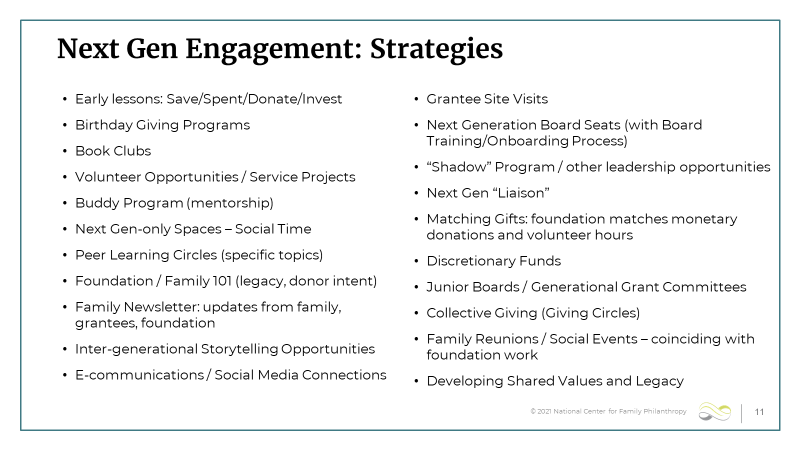Takeaways Blog on Engaging the Next Generation

This blog summarizes key notes from our November Fundamentals of Family Philanthropy Webinar.
Multigenerational families use varying, and often multiple, strategies to engage the next generation in philanthropy. Yet why it is important to engage subsequent generations in the family philanthropy, and how does it impact the culture and operations of the foundation? Successful next-gen participation depends on a number of considerations, including how to promote learning, empower next generation family members, and offer leadership positions. In the National Center for Family Philanthropy’s recent webinar, Allison Hale, Cadence Miller, and Sharmila Rao Thakkar discussed why it is important to engage the next generation, strategies for teaching youth and young adults about philanthropy, and shared how to make space for youth leadership during these learning experiences. Here are important takeaways from the discussion.
Engaging the next generation is an important part of family philanthropy because it builds a culture of collaborative giving, prepares younger family members for leadership, and carries forward family legacy and donor intent.
Providing learning opportunities for the next generation of family members helps build a culture around giving together. Younger family members need opportunities to get involved within the philanthropy and the family itself—to get to know their relatives better, to understand the power and significance of giving, and to learn more about the nuts and bolts of the foundation (or other giving vehicle). For instance, bringing youth on site visits not only shows them the impact of a grant and the important work of the nonprofit partner, but also presents a bonding opportunity with their relatives and instills a sense of engagement with the foundation.
These opportunities can be formal, like a junior board, mentoring program, or giving circle, or informal, such as a book club, family retreat, or next-gen only peer time. Formal and educational, or informal and social, each strategy will provide an on-ramp to connect next-gen to the family, to each other, and to the philanthropy. When next-gen family members are actively taught and brought along through the work of the philanthropy, they grow their own set of skills and perspectives, and are better prepared to take on the responsibility of board service or other leadership as they grow older.
Engaging the next generation also helps to carry forward family legacy and donor intent. Many founders and families want multiple generations to be involved in the philanthropy—to stay connected, but to also help chart the future of the giving together as a collective group. Without avenues of engagement, the next-gen may grow disengaged or too busy with other life pursuits to take the reigns of the philanthropy. Importantly, bringing on the next-gen also assures that fresh ideas and new perspectives make their way into the philanthropy over time. While donor intent and the current culture will still influence the direction of the foundation, younger generations can offer new insights and adapt current practices to an existing strategy.
There many strategies to engage children, youth, and adults in the philanthropy. Some options are:

Slide 11 from “Engaging the Next Generation” presentation, developed by Sharmila Rao Thakkar
Regardless of how next-gen are engaged—the format, age, or stage—there are considerations for how best to involve and educate next-gen that ring true across any strategy. Sharmila Rao Thakkar, the webinar moderator and philanthropic consultant, laid out a number of reflections:
- Prioritize early, often, continuous learning: The earlier children are exposed to giving, the more opportunities they have to make a meaningful connection with the purpose of their family’s philanthropic work. Providing frequent and continuous entry and exit points to learning allows the next-gen to be involved at their own pace, yet still be connected to the philanthropy.
- Make space and take space: Older generations must intentionally make space at the table for the future generations. Part of that is offering actual opportunities to participate in decision making, while the other part is creating a comfortable and encouraging culture where next-gen feel empowered to take the space at the table.
- Commit resources and time: This work requires time commitments—family involvement, and often staff time allocations so there is a stable position guiding this work. It also takes resources, and families that dedicate funding to youth philanthropy or next-gen engagement programs see the benefits over time.
- Explain roles, responsibilities, opportunities (time, talent, treasure, ties): There are many ways to be involved outside of grantmaking. It is important to share the multitude of ways that you can provide support, be it through your time, talent, treasure, or ties, and the different roles and responsibilities each opportunity requires.
- Be flexible, open, curious: It seems simple, but maintaining a flexible and open mindset allows for the next-gen to also be curious and interested, and opens the door for new ideas and perspectives.
To learn more, the recording and transcript of “Engaging the Next Generation” are available exclusively to NCFP Friends of the Family and Partner Subscribers.
Jen Crino is a Program Manager at NCFP
